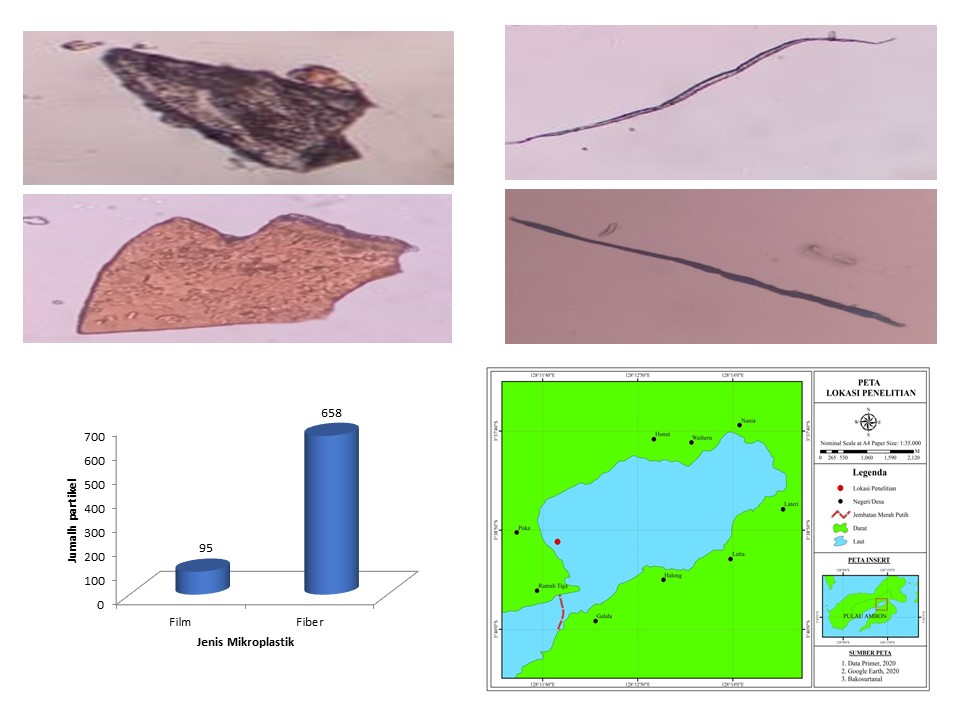Identification of The Presence of Microplastics in Caranx sexfasciatus Cultivated in The Inner Ambon Bay
DOI:
https://doi.org/10.46252/jsai-fpik-unipa.2021.Vol.5.No.1.117Keywords:
Microplastic, film, fiber, Caranx sexfasciatus, Ambon BayAbstract
The plastic waste production is continuing to increase in waters and has become a problem worldwide. This material, in particular for the size less than 5mm, called microplastic, has been polluting the environment and humans. The aim of this research, therefore, is to identify the presence of types and amount of microplastics in Caranx sexfasciatus cultivated in Ambon Bay waters. The research was conducted in April 2020 in some floating cages as a sampling site located in the Inner Ambon Bay. A purposive sampling method was applied to collect data. The types and amount of microplastics were analysed in zoology laboratory, Mathematics and Science Faculty University of Pattimura (FMIPA Unpatti). Data analysis was carried out by displaying the type and number of microplastics and discussed further. The result revealed that there were types of film and fiber with 95 particles and 685 particles, respectively. The presence of these two types of microplastics is due to the waste disposal activities that derive from the adjacent community and are carried away by tidal currents.
Downloads
References
Azhari, D., & Tomasoa, A. M. (2018). Kajian Kualitas Air dan Pertumbuhan Ikan Nila (Oreochromis niloticus) yang Dibudidayakan dengan Sistem Akuaponik. Akuatika Indonesia, 3(2), 84–90. https://doi.org/10.24198/jaki.v3i2.23392
BPS. (2020). Kota Ambon Dalam Angka 2020. BPS Kota Ambon. https://ambonkota.bps.go.id/publication/2020/04/27/0072157fa7d7bf288ceb130a/kota-ambon-dalam-angka-2020.html
Chatterjee, S., & Sharma, S. (2019). Microplastics in Our Oceans and Marine Health. Field Actions Science Reports. The Journal of Field Actions, 19, 54–61.
Crawford, C. B., & Quinn, B. (2017). Microplastics, standardisation and spatial distribution. In Microplastic Pollutants. https://doi.org/10.1016/b978-0-12-809406-8.00005-0
Critchell, K., & Hoogenboom, M. O. (2018). Effects of microplastic exposure on the body condition and behaviour of planktivorous reef fish (Acanthochromis polyacanthus). PLoS ONE, 13(3), 1–19. https://doi.org/10.1371/journal.pone.0193308
De Sales-Ribeiro, C., Brito-Casillas, Y., Fernandez, A., & Caballero, M. J. (2020). An end to the controversy over the microscopic detection and effects of pristine microplastics in fish organs. Scientific Reports, 10(1), 1–19. https://doi.org/10.1038/s41598-020-69062-3
Dewi, I. S., Budiarsa, A. A., & Ritonga, I. R. (2015). Distribusi mikroplastik pada sedimen di Muara Badak , Kabupaten Kutai Kartanegara Distribution of microplastic at sediment in the Muara Badak Subdistrict , Kutai Kartanegara Regency. Depik, 4(3), 121–131. https://doi.org/10.13170/depik.4.3.2888
GESAMP. (2016). Sources, fate and effects of microplastics in the marine environment: part 2 of a global assessment. In: Kershaw, P.J., and Rochman, C.M., eds, Rep. Stud. GESAMP No. 90 (96 pp). Reports and Studies GESAMP, 93, 220 p.
Kershaw Peter J. (2016). Marine Plastic Debris and Microplastics Global lessons and research to inspire action and guide policy change. In UNEP. https://doi.org/10.1017/CBO9781107415324.004
Lusher, A., Hollman, P., & Mandoza-Hill, J. . J. (2017). Microplastics in fisheries and aquaculture. In FAO Fisheries and Aquaculture Technical Paper. https://doi.org/dmd.105.006999 [pii]\r10.1124/dmd.105.006999
Manullang, C. Y. (2019). The abundance of Plastic Marine Debris on Beaches in Ambon Bay. IOP Conference Series: Earth and Environmental Science, 253(1). https://doi.org/10.1088/1755-1315/253/1/012037
Nagarajan, V. M., Gopinath, K. P., Krishnan, A., Rajendran, N., & Krishnan, A. (2020). A critical review on various trophic transfer routes of microplastics in the context of the Indian coastal ecosystem. Watershed Ecology and the Environment, 137421. https://doi.org/10.1016/j.scitotenv.2020.137421
Nelms, S. E., Galloway, T. S., Godley, B. J., Jarvis, D. S., & Lindeque, P. K. (2018). Investigating microplastic trophic transfer in marine top predators. Environmental Pollution, 238(2018), 999–1007. https://doi.org/10.1016/j.envpol.2018.02.016
NOAA. (2013). Microplastic Marine Debris. National Ocean Service Website.
Plastics, E. (2019). Plastics-The Facts 2019 An Analysis of European Plastics Production, Demand and Waste Data. https://www.plasticseurope.org/application/files/1115/7236/4388/FINAL_web_version_Plastics_the_facts2019_14102019.pdf
Rochman, C. M., Hoh, E., Kurobe, T., & Teh, S. J. (2013). Ingested plastic transfers hazardous chemicals to fish and induces hepatic stress. Scientific Reports, 3(3263). https://doi.org/10.1038/srep03263
Smith, M., Love, D. C., Rochman, C. M., & Neff, R. A. (2018). Microplastics in Seafood and the Implications for Human Health. Current Environmental Health Reports, 5(3), 375–386. https://doi.org/10.1007/s40572-018-0206-z
Widianarko, B., & Hantoro, I. (2018). Mikroplastik Dalam Seafood dari Pantai Utara Jawa.
Zhang, X., Zhang, Y., Zhang, Q., Liu, P., Guo, R., Jin, S., Liu, J., Chen, L., Ma, Z., & Ying, L. (2020). Evaluation and analysis of water quality of marine aquaculture area. International Journal of Environmental Research and Public Health, 17(4), 1–15. https://doi.org/10.3390/ijerph17041446



















